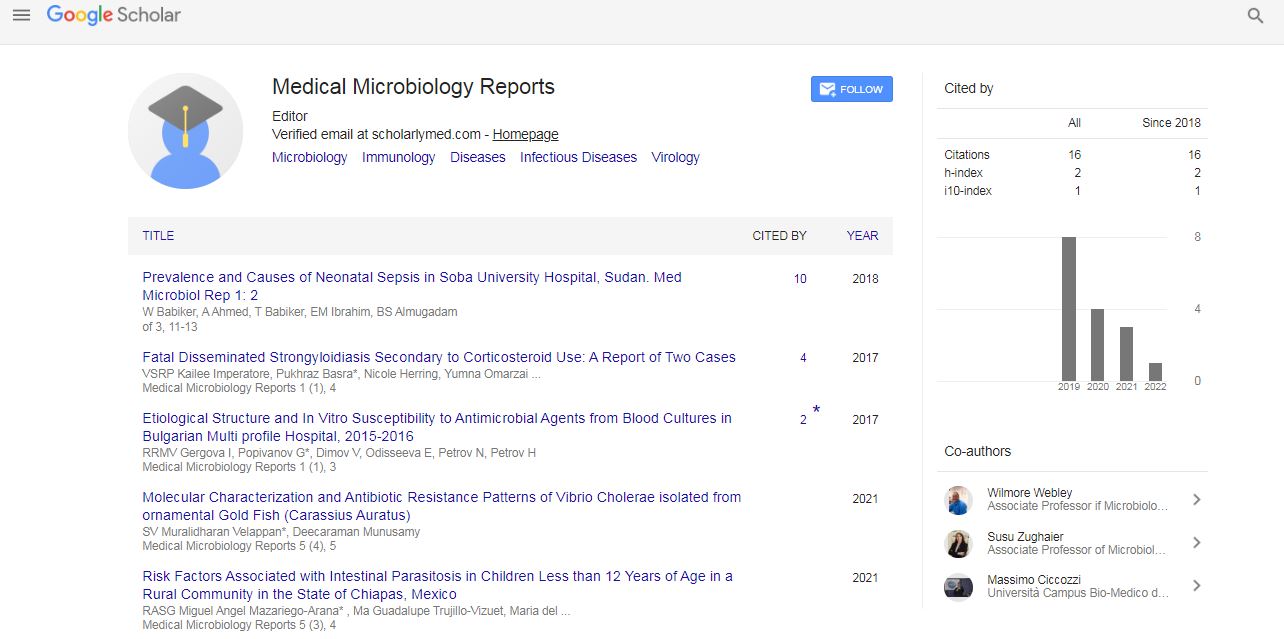Commentary, Med Microbiol Rep Vol: 7 Issue: 3
Viral Ecology: Exploring the Impact of Viruses on Ecosystems
Rezak Abdi*
Department of Health Sciences, Pierre Louis Epidemiology and Public Health Institute, Paris, France
*Corresponding Author: Rezak Abdi,
Department of Health Sciences, Pierre
Louis Epidemiology and Public Health Institute, Paris, France
E-mail: abdi.rezak@edu.fr
Received date: 01 September, 2023, Manuscript No. MMR-23-117988;
Editor assigned date: 04 September, 2023, PreQC No. MMR-23-117988 (PQ);
Reviewed date: 18 September, 2023, QC No. MMR-23-117988;
Revised date: 25 September, 2023, Manuscript No. MMR-23-117988 (R);
Published date: 02 October, 2023 DOI: 10.4172/MMR.1000347
Citation: Abdi R (2023) Viral Ecology: Exploring the Impact of Viruses on Ecosystems. Med Microbiol Rep 7:3.
Description
Virology is the branch of microbiology dedicated to the study of viruses, the smallest and simplest infectious agents known to science. These microscopic entities have challenged scientists for centuries, primarily due to their dual nature: They are considered both living and non-living.
The world of viruses
Viruses, unlike bacteria and other microorganisms, are not considered living organisms. They lack the cellular structure and metabolic processes necessary for life. Instead, they are essentially genetic material (either DNA or RNA) enclosed within a protein coat known as a capsid. Some viruses may have additional structures, such as lipid envelopes. This minimalist design allows them to be incredibly efficient at what they do: Infecting host cells and hijacking their machinery to replicate.
Viral classification
Virologists have classified viruses into various categories based on several factors:
Genetic material: Viruses can have either DNA or RNA as their genetic material. This is one of the key criteria used to categorize viruses. DNA viruses, like herpes viruses, typically replicate in the nucleus of the host cell, while RNA viruses, such as the influenza virus, replicate in the cell's cytoplasm.
Shape and structure: The shape of a virus and the presence or absence of an envelope is important for classification. Viruses can have various shapes, including helical, icosahedral, or complex structures. Enveloped viruses, like the Human Immunodeficiency Virus (HIV), have a lipid bilayer envelope surrounding their capsid.
Host range: The specific types of cells a virus can infect are often used for classification. Some viruses are highly host-specific, while others can infect a wide range of species, including humans, animals, and plants.
Mode of transmission: Viruses can be transmitted through various means, such as respiratory droplets, direct contact, vector-borne transmission, or via contaminated water or food. Understanding these transmission methods is crucial in managing viral diseases.
Viral replication
Viral replication is a complex process that depends on the host cell's machinery. The general steps involved in viral replication include:
Attachment: Viruses bind to specific receptors on the surface of host cells. This binding is highly specific and is a critical determinant of host specificity.
Entry: Viruses enter the host cell, either through membrane fusion or endocytosis, depending on whether they have an envelope.
Un-coating: The viral genetic material is released from the capsid and enters the host cell's cytoplasm or nucleus.
Replication and transcription: The viral genetic material is replicated, and new viral proteins and RNA are synthesized using the host's machinery.
Assembly: New viral particles are assembled from the replicated genetic material and synthesized proteins.
Release: Mature viruses are released from the host cell, either by causing cell lysis or through a budding process that preserves the host cell's integrity.
The impact of viruses
Viruses have a profound impact on various aspects of life, including human health, ecosystems, and even technology.
Human health: Many human diseases are caused by viruses. Examples include the common cold, influenza, HIV/AIDS, COVID-19, and hepatitis. Vaccines, antiviral drugs, and public health measures are essential tools for controlling viral infections.
Agriculture: Plant viruses can devastate crops, leading to reduced yields and economic losses. Studying these viruses is crucial for crop protection and food security.
Environmental impact: Viruses play a crucial role in marine ecosystems by infecting and controlling the population of phytoplankton, which influences carbon and nutrient cycling in the oceans.
Biotechnology: Viruses can be harnessed for various biotechnological applications, such as gene therapy, viral vectors for gene delivery, and the production of recombinant proteins.
Emerging diseases: The emergence of new viral diseases, such as zoonotic diseases (those transmitted from animals to humans), highlights the need for on-going research in virology to better understand and combat these threats.
 Spanish
Spanish  Chinese
Chinese  Russian
Russian  German
German  French
French  Japanese
Japanese  Portuguese
Portuguese  Hindi
Hindi 
